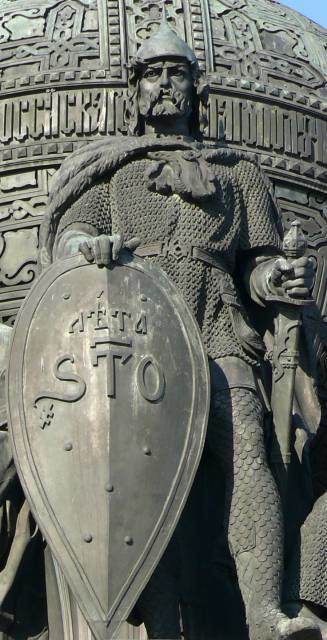Reign 862–879 Religion Paganism Parents Godoslav, Umila | Children Igor of Kiev Predecessor New creation Siblings Truvor, Sineus | |
 | ||
Name Rurik Rurik Similar People Oleg of Novgorod, Igor of Kiev, Sviatoslav I of Kiev, Olga of Kiev, Nicholas Roerich | ||
Rurik s death montage foal shot in marion va
Rurik (also Riurik; Old Church Slavonic Рюрикъ Rjurikŭ, from Old Norse Hrøríkʀ; c. 830 – 879), according to the 12th-century Primary Chronicle, was a Varangian chieftain of the Rus' who in the year 862 gained control of Ladoga, built the Holmgard settlement near Novgorod. He is the founder of the Rurik Dynasty, which ruled the Kievan Rus' and its successor states, including the Grand Duchy of Moscow and the Tsardom of Russia, until the 17th century.
Contents
- Rurik s death montage foal shot in marion va
- The life and death of rurik
- Life
- Archaeological evidence
- Possible identity with Rorik of Dorestad
- Genealogy
- References

The life and death of rurik
Life

The only information about Rurik is contained in the 12th-century Primary Chronicle written by one Nestor, which states that Chuds, Eastern Slavs, Merias, Veses, and Krivichs "...drove the Varangians back beyond the sea, refused to pay them tribute, and set out to govern themselves". Afterwards the tribes started fighting each other and decided to invite the Varangians, led by Rurik, to reestablish order.

According to the Primary Chronicle, Rurik was one of the Rus', a Varangian tribe likened by the chronicler to Danes, Swedes, Angles, and Gotlanders.

Rurik remained in power until his death in 879. His successors (the Rurik Dynasty) moved the capital to Kiev and founded the state of Kievan Rus', which persisted until the Mongol invasion in 1240. A number of extant princely families are patrilineally descended from Rurik, although the last Rurikid to rule Russia, Vasily IV, died in 1612.
According to the entries in the Radzivil and Hypatian Chronicles under the years 862–864, Rurik’s first residence was in Ladoga. He later moved his seat of power to Novgorod, a fort built not far from the source of the Volkhov River. The meaning of this place name in medieval Russian is 'new fortification', while the current meaning ('new city') developed later.
Archaeological evidence
In the 20th century, archaeologists partly corroborated the chronicle's version of events. It was discovered that the settlement of Ladoga, whose foundation has been ascribed to Rurik, was actually established in the mid-9th century, although doubt is now cast on this by the dendrochronological evidence that Ladoga existed by the mid-8th century. Earthenware, household utensils, and types of buildings from the period of Rurik's purported foundation correspond to patterns then prevalent in Jutland. but mostly the excavations denied most of the chronicle's data about Rurik's arrival when it was apparent that the old settlement stretched to the mid-8th century and the excavated objects were mostly of Finno-Ugric and Slavic origin, dated to the mid-8th century, which showed the settlement was not Scandinavian from the beginning.
Possible identity with Rorik of Dorestad
The only similarly named figure described in the Carolingian Annales Fuldenses and Annales Bertiniani was Rorik of Dorestad (also spelled Rørik, Rörik, Roerik, Hrörek, etc.), a Germanic king from the royal Scylding house of Haithabu in the Jutland Peninsula. Since the 19th century, there have been attempts to identify him with the Rurik of Russian chronicles.
Rorik of Dorestad was born about ca. 810–820 to Ali Anulo, 9th king of Haithabu. Frankish chroniclers mention that he received lands in Friesland from Emperor Louis I. This was not enough for him, and he started to plunder neighbouring lands: he took Dorestad in 850, captured Haithabu in 857, and looted Bremen in 859. The Emperor was enraged and stripped him of all his possessions in 860. After that, Rorik disappears from the Western sources for a considerable period of time, while only two years later, in 862, the Russian chronicle's Rurik arrives in the eastern Baltic, builds the fortress of Ladoga, and later moves to Novgorod.
Rorik of Dorestad reappeared in Frankish chronicles in 870, when his Friesland demesne was returned to him by Charles the Bald; in 882 Rorik of Dorestad is mentioned as dead (without a date of death specified). The Russian chronicle places the death of Rurik of Novgorod at 879, a three year gap prior than the Frankish chronicles. According to Western sources, the ruler of Friesland was converted to Christianity by the Franks. This may have parallels with the Christianization of the Rus', as reported by Patriarch Photius in 867.
The idea of identifying the Rurik of Nestor's chronicle with Rorik of Dorestad of the Carolingian chronicles was revived by the anti-Normanists Boris Rybakov and Anatoly H. Kirpichnikov in the mid-20th century, while modern scholars like Alexander Nazarenko object to it. The hypothesis of their identity currently lacks support among scholars, though support for a "Normannic" (i.e. Norse, rather than Slavic) origin of the Rus' has increased.
Genealogy
The Rurik dynasty (or Rurikids) went on to rule the Kievan Rus', and ultimately the Tsardom of Russia, until 1598, and numerous noble Russian and Ruthenian families claim a male-line descent from Rurik. Vasily Tatishchev (a Rurikid himself) claimed that Rurik was of Wendish extraction and went so far as to name Rurik's wife, Efanda of Norway (Edvina); mother, Umila; his maternal grandfather, Gostomysl; and a cousin, Vadim (apparently basing his account on the lost Ioachim Chronicle).
